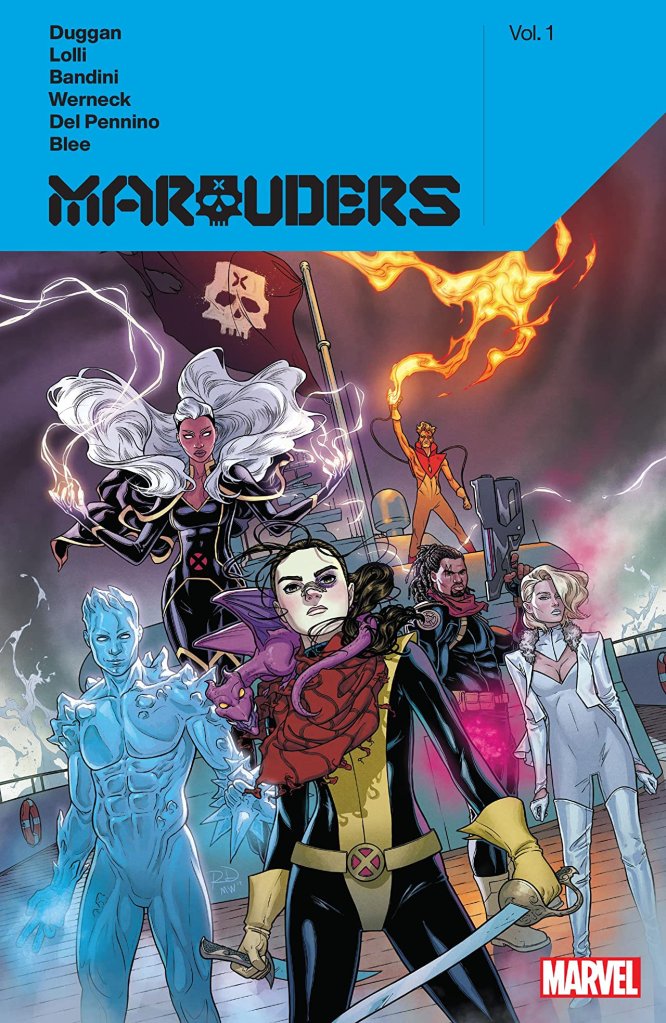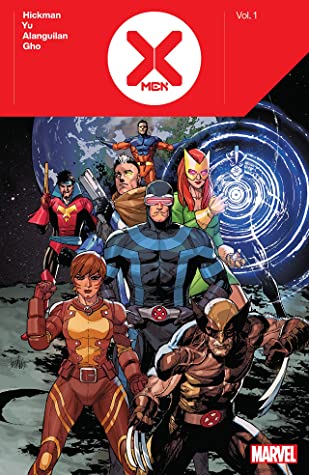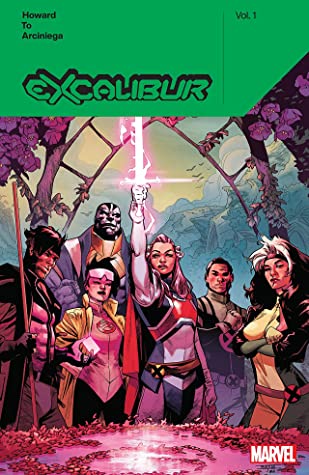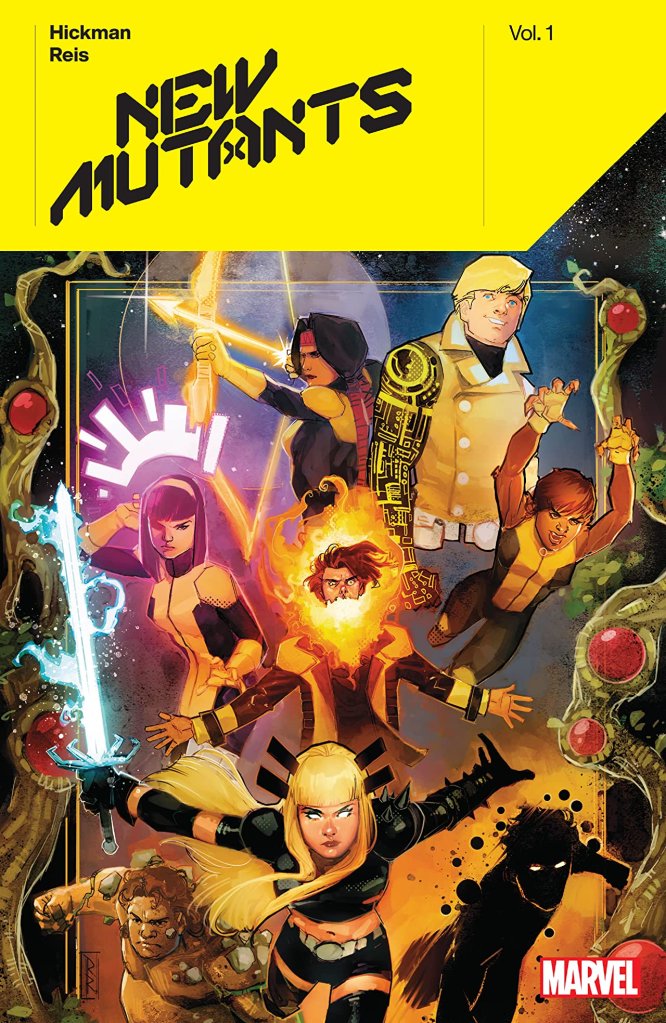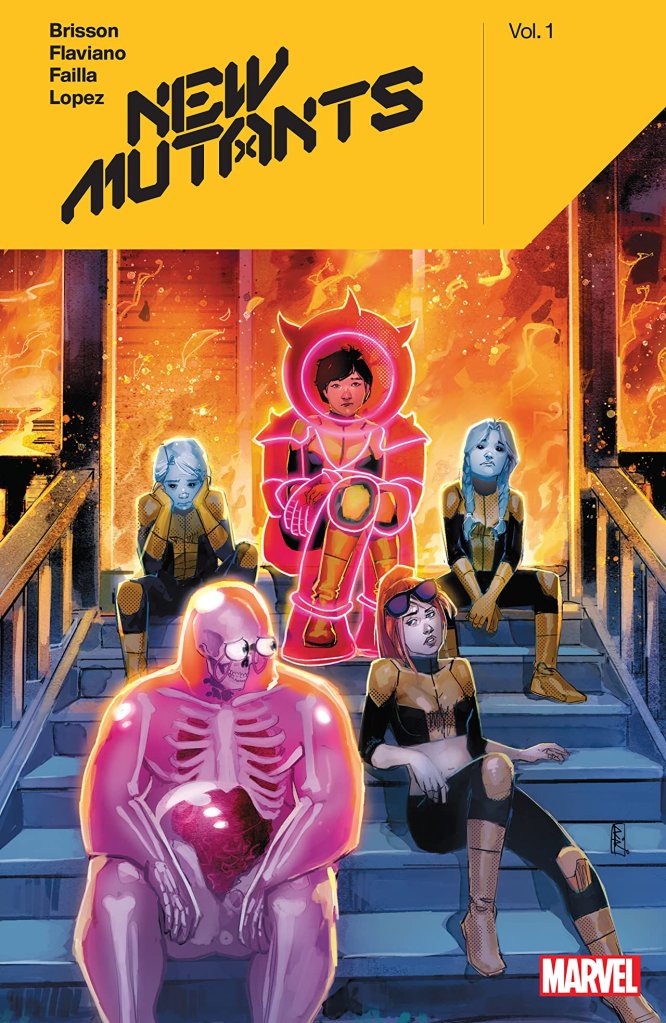Note: Reviews are in order that I read them, not recommended reading of the Dawn of X titles ( a combination of the fact that the order isn’t in Marvel Unlimited for some reason; I’m biased towards Kate Pryde and wanted to read her stuff first; I am lazy and unable to read 6 different titles at once.)
X-Men: Marauders
by Gerry Duggan, Matteo Lolli, Michele Bandini, Lucas Werneck
collects Marauders #1-6
This is my first Dawn of X book since HOX/POX, and it’s out of order but I don’t care – Kate Pryde’s the lead and that means it’s the top of my pile. This is a fun romp that makes Kate the captain of the Marauders, keeping the shipping lanes open for Hellfire Club and rescuing mutants from hostile countries (though why she can’t get into Krakoa is convoluted and not explained – hopefully a setup for Hickman’s long game). This Kate is a bit rough around the edges, more drunk and tattooed, but frankly I love it. She’s joined by some favorites including Iceman, Storm, and a hilarious OG Pyro. I don’t care much for Sebastian Shaw, the art is run of the mill and the page-long prose excerpts are annoying AF…but I’m enjoying this. (And good thing I know spoilers for the end, otherwise I’d be writing a very different review.)
X-Men: Marauders, vol 2
by Gerry Duggan, Stefano Caselli, Matteo Lolli, Edgar Delgado
collects Marauders #7-12
** spoilers** Loved binge reading this after finishing Marauders volume 1. Five stars for Duggan’s perfect depiction of Kate and Kurt’s relationship, and the way he weaved in some great Jewish symbolism (the number 18) and that Kurt recognized it and also gave Kate back her Star of David, and thank God finally made her queer into canon. Some emotional beats were off, sorry, why would Kate be cremated if she’s Jewish (assuming she’s more traditional even though some progressive Jews are cremated)? Didn’t Kate deserve Xavier’s eulogy in-comic, because we know it would be resolved in the next issue? But I’ll overlook it for how significant this arc is for Kate’s character after decades of queer baiting, it’s about goddamn time. I wish it had happened with Rachel Summers, but we have time, don’t we? Caselli’s art is phenomenal. Lolli’s was a bit disappointing in the last issue, but I think he made Kate resemble her earliest look on purpose after she was resurrected.
X-Men
by Jonathan Hickman, Leinil Francis Yu, Gerry Alanguilan, RB Silva
collects X-Men #1-6
Not as much fun as Marauders but still great, even if a little disjointed. “Table setting” doesn’t do this volume justice – Hickman is basically setting up entire banquets in each issue. I’m sure the payoff will be great but at times it feels like a little much to keep in the air all at once. While a few concepts were confusing (the Vault), the fourth issue was a fascinating study into Magneto and Xavier’s evolved philosophies. I also still have a love-hate relationship with the prose pages – sometimes it provides eerie foreshadowing (#5) or amusement (the menu in #4) and other times it feels clunky…or, to continue extending the metaphor, table setting in another room altogether. The art is also great. I loved Silva & Gracia’s art in issue five with the Vault. Yu & Alanguilan’s work feels like classic X-Men but it’s a bit too rough for me.
X-Men: Excalibur
by Tini Howard, Marcus To, Erick Arciniega, VC Cory Petit
collects X-Men Excalibur #1-6
I thought this was a lot of fun, even though Marvel’s magical corner of the universe is unfamiliar to me – I always associated Morgan Le Fey with Etrigan and Zatanna (mostly thanks to the DCAU). The new Excalibur team is a fun group and Apocalypse continues to be an interesting wildcard compared to some of the other mutant villains like Shaw. I’m happy to see Rogue and Gambit’s story continue as a married couple post their disappointing solo series, even though Rogue spent most of this arc as Snow White. And while I’m not familiar with the Braddock twins their relationship as siblings feels unique and Betsy is such a solid character. Marcus To’s art is just phenomenal and his art along with Arciniega and Petit created a strong fantasy and magic aura.
New Mutants
by Jonathan Hickman & Rod Reis
collects New Mutants (2019) #1-2, 5, 7
Hickman and Reis’ New Mutants arc was honestly way better than I expected it to be, because I usually don’t associate Hickman’s writing with upbeat, humorous, 20’s superheroes fare – and yet he completely pulls it off. I’m not familiar with a lot of these characters (I haven’t read much New Mutants) but loved getting to know them during their space romp gone sideways, and Roberto da Costa is a hilarious, self centered lead with excellent recaps. I think the writer is a bit in love with him too however, and I would have liked to see more Magick and Mirage.
Reis’ art is extraordinary, and I love the funky colors and multimedia feel to his work. But his style is so work intensive that they needed to include a completely separate arc (at least I assume that’s what happened) for issues 3, 4 and 6. This arc isn’t terrible, but it also isn’t great, and it completely throws off the pacing. (Reviewing this arc separately.) This only happened to me because I read on Marvel Unlimited; the collected editions separate the arcs out. If you’re in the same boat as me, I would highly recommend reading the arcs separately. It also meant some of the main arc needed to be truncated – and while the recaps are funny, it also covers ground that clearly would have been those missing issues.
New Mutants is a great first volume, but it would have been a home run if every issue was dedicated to the main arc.
New Mutants
by Ed Brisson, Flaviano, Marco Failla, Carlos Lopez
collects New Mutants (2019) #3-4, 6, 8-12
Man, Brisson’s New Mutants is a completely different turn from Hickman. It’s darker and way more violent. The first arc took a violent turn that surprised me, followed by a new mission to Russia (with heroes from both missions), where a new mutant’s nightmares are creating a new reality. The final, shorter arc involves the heroes tracking down the creators of a website doxxing mutants, whose actions have led to violence and murders – while a good tie in to current events, and certainly (sadly) a realistic development post-Krakoa, it was still a bit depressing. (Also depressing: their HQ is in my hometown.)
The stories themselves aren’t bad, and I really like the cast and how diverse they are, but it’s certainly a 180 from Hickman’s tone. Also a gaffe I rarely see in comics – a line of dialogue is accidentally repeated on the same page. Flaviano, Failla and Lopez’s art was fine but nothing to write home about. Finally, I loved the development for Glob most of all – what a great character. He should just be in everything.
